Lemang is a very traditional, favourite childhood food of mine that we never cooked at home! Little did I know, when I first published this in 2018 on LinsFood, how crucial it was going to be for so many of you as Eid 2020 was spent in Lockdown! And 2021 too!
Estimated reading time: 12 minutes
Table of contents
- What is Lemang?
- Origin of Lemang
- Lemang in Indonesia
- Lemang Recipe without Bamboo
- And this is how I make Lemang without Bamboo:
- How to Cook Lemang at Home
- Glutinous Rice doesn’t contain Gluten!
- Banana leaves for lemang
- How to soften Banana Leaves
- Coconut Milk for Lemang
- Canned Coconut Milk is Fine!
- Pandan Leaves
- How to Serve Lemang
- Recipes that will go with Lemang
- How to Store Leftover Lemang (and Lontong)
- Reheating Lemang
- Images by LinsFoodies
- Comments by LinsFoodies

What is Lemang?
Lemang is glutinous rice cooked in banana leaf lined bamboo poles. While in Malaysian and Indonesian villages, families may cook it themselves, it has long been something most folks buy at food stalls, and especially night markets. This is how lemang is cooked traditionally:
- The bamboo poles are lined with banana leaves
- Then filled with rice and a pandan leaf
- Rice is topped with coconut milk, seasoned with salt and sugar
- The bamboo is placed over an open fire and left to cook for 3-4 hours (image below)
⇒ The bamboo lends an inimitable woody, smoky aroma and flavour to the lemang.

Origin of Lemang
While the method of cooking rice in bamboo, over an open fire, is found all over South East Asia, Lemang is Malaysian. Specifically, lemang comes from the Iban people of Sarawak, on the island of Borneo. Sarawak, along with Sabah, form East Malaysia, as opposed to West Malaysia, which comprises all the states on the Peninsular.
The Ibans form the biggest ethnic group in Sarawak, and are also known as Sea Dayaks, given their propensity in the early days, of travelling by sea and river (and headhunting!). It is thought that this how they made their way to Borneo from Indonesia. The Dayaks are the indigenous tribal people of Borneo.
So lemang is believed to have come from the Ibans, because they have a long history and tradition of cooking food in bamboo. Anything cooked in bamboo is called pansoh, whether it’s rice, meat, vegetables or seafood.

Lemang in Indonesia
Lemang is also extremely popular in many parts of Indonesia and has become entwined with many traditional ceremonies, happy and sad. Depending on the area, it is also known as lamang or malamang, and is served up with various fillings, both sweet and savoury:
- lamang pisang (bananas) – total yum!
- lamang tapai (fermented) – mmm, not my thing
- lamang singkong (cassava) – nice, but not a favourite of mine
- lamang baluoh (with coconut and palm sugar) – I love this one!
Lemang Recipe without Bamboo
I spent a long time trying to get my hands on bamboo that was thick enough to make lemang with. In vain. One year, in desperation, I decided to make lemang the way my granny made her quick lontong (pronounced loan-tohng, silent h).
Lontong is compressed rice wrapped up in banana leaves and served with a vegetable curry called sayur lemak or the Indonesian sayur lodeh.

My granny would cook the rice, then wrap it up in banana leaves and leave it in the fridge until the next day. So that’s how I made my lemang the first few times: cooked the glutinous rice, then wrapped it up.
A couple of epiphanies led me to this final lemang recipe without bamboo, which simply cannot be bettered. Well, unless I get my hands on the d–n bamboo! So if you are in the UK, and you know where I can get good sized bamboos, you know what to do!
And this is how I make Lemang without Bamboo:
- Soak the glutinous rice for 3 hours.
- Line the base of a saucepan (or rice cooker) with banana leaf.
- Add the rice, coconut milk, salt, sugar, top with another banana leaf, and cook for 30 minutes (or so).
- Wrap the cooked (slightly cooled) rice in banana leaves.
- Either roast in the oven or better still, place on the bbq for that smoky flavour from the burnt banana leaves and wood chips.
⇒ By roasting or barbecuing the lemang, we are “burning” the banana leaves to mimic the smoky flavour of the traditional bamboo recipe.
⇒ That’s why cooking it on the barbecue (grill, in American speak), is better, as you get the smoky aroma from the coals. Well, unless you have a gas barbie!
⇒ Needless to say, we are still missing the woody aroma of the bamboo. I make up for this by throwing some wood chips in the fire. Skip this part if you find it too much work!
Roast your Lemang in an Air Fryer
One of my readers (@thatolivechick on Instagram) who’s made this lemang recipe before, tested it out in her air fryer this year. She said it was amazing. So if you have an air fyer, that’s the way to go.
And here’s a tip: add some barbecue wood chips in the base of your air fryer for that smoky effect. You can use them without soaking, but I think soaking the wood chips creates a better aroma.

How to Cook Lemang at Home
Glutinous Rice for Lemang
There are different types of glutinous rice, and short grain as well as long. In the video, you can see that I’m using the long grain variety from Thailand, something I grew up using in Singapore. This is also the rice we would use for many Malay sweet rice desserts.
This long grain variety is only available at our local Chinese grocer. As I’ve said before, get it online if you can. To make “specialist food”, you need to go online many a time!
If you can’t get the long grain variety I’m using, any sticky short grain rice will do, like rice used for rice pudding and sushi rice. If that’s not available, jasmine rice is your next best bet.
Glutinous Rice doesn’t contain Gluten!
Glutinous rice is rice. Its name comes from the fact that when it’s cooked, its grains become glue like and sticky and can be easily rolled and formed into balls. It is very popular all over East and South East Asia.
We tend to soak the rice overnight when using it in most recipes. I’ve found that a minimum of 3 hours will suffice, but if you have the time, soak it overnight.
If you forget to soak it, up the water content by 250ml (1 cup) and cook it until the liquid’s all evaporated.
You can use your rice cooker to cook the glutinous rice.

Banana leaves for lemang
I have potted banana plants in the summer. But because I’m too lazy to look after them in the winter, I start again every summer! So when the guys are thriving, I have fresh banana leaves to use in the kitchen. BUT that’s like a months of the year only.
Well I finally planted my 2 banana plants in the ground last summer. It’s November 2022, and they’re both still perfectly fine. So fresh banana leaves longer!
The rest of the time, I rely on frozen banana leaves from my local Chinese grocer, about 20 minutes away. Or the Indian ones, 30 minutes away. Or Amazon, or any online Asian shop. So if you don’t have access to fresh, that’s the way to go.
No joy? No banana leaf source at all? Follow the recipe, then roll or wrap the cooked rice up in foil. So you can at least enjoy the coconut flavoured, compressed glutinous rice sans banana leaf.
Or I should say it in Malay, shouldn’t I? It is a Malay recipe, after all! So that would be lemang tanpa daun pisang (without banana leaf)!

How to soften Banana Leaves
See the video below. Banana leaves need to be softened to roll or fold “properly”. They will tear, otherwise, as you are working with them. If you have access to fresh banana leaves, lose the thick, middle vein, cutting on either side of it, for the leaves, before proceeding.
When using frozen, the banana leaves are not as sturdy as fresh ones, and are prone to tearing, so handle with care.
You can soften banana leaves in the following 2 ways:
- Place your banana leaves in a large shallow container and pour boiling water, ensuring that the banana leaves are fully submerged. You only need it soaking for a minute or two. Dry before use.
- As you see in the video, hold your leaf over a medium-low flame and move it all around. The banana leaf will become a brighter green and shiny to indicate that it’s softened and pliable.
Coconut Milk for Lemang
How much coconut milk you use is purely a matter of taste. The more you use, the richer your lemang. When I’m making stuffed lemang (a recipe for another day), the cooking liquid is purely coconut milk, because I’m aiming for a full on flavour, as the final lemang will be eaten as a snack, more than anything else.
However, a “plain” lemang is eaten pretty much like you would eat rice, lontong or ketupat (another type of compressed cake); with curry, namely beef rendang (or any rendang). Rendang is a highly spiced and rich curry, with a coconut base, so having a coconut heavy lemang is just overdoing it a little, to my taste. And my digestion!
But it’s a matter of preference, so if you prefer your lemang rich with whatever curry you are serving, then by all means use only coconut milk.
Canned Coconut Milk is Fine!
I don’t have access to fresh coconut milk, not taking into account frozen or dried desiccated coconut. So I always use organic coconut milk out of a can. You know how the fat floats and solidifies at the top of the can? We need to shake the milk well before opening it, for this recipe.
If you are using exactly the amount of coconut milk as stated in this recipe, keep the rest in the fridge, in a covered container, and use within 2 days. Or, freeze it until needed.
If using freshly grated coconut, you just want half a coconut mixed with 250ml (1 cup) water. AND the other cup of water for the full recipe.

Pandan Leaves
Click here to read more on LinsFood. The pandan leaf has a wonderfully, sweet aroma with dashes of freshly cut grass, and is a very common ingredient in South East Asian cooking, for flavouring both sweet and savoury dishes.
I have a pot of this but before I could get my hands on a plant, I resorted to the frozen kind too. In fact, I still freeze excess leaves to preserve them.
If you can’t get pandan leaves, leave them out or see if you can get hold of pandan essence or the Indian kewra from the usual suspects. I am not a fan of pandan essence as it is, to my knowledge, artificial. But things may have moved on in the last 30 years, who knows!
How to Serve Lemang
It is traditionally eaten with Beef Rendang, as mentioned. However, I’ve even served it with Indian curries, and naturally, Thai curries, as the latter bear a strong resemblance to Malay curries.
The Thai and Indian curries are on LinsFood.
Recipes that will go with Lemang
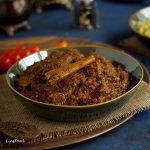
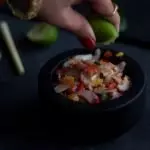

How to Store Leftover Lemang (and Lontong)
The best way to store lemang is by slicing it up first. Then, place it in an airtight container or even a freezer safe bag. This way, reheating it only takes a few minutes, and you don’t run the risk of it not being heated through.
Fridge
Lemang will keep in the fridge for a few days. The common consensus seems to be 5 days, but my advice is to store it for 3 days. Any longer and the lemang starts taking on a “not fresh” aroma.
Place it in an airtight container or a ziplock bag.
Freezer
Leftover lemang can be stored in the freezer for up to 3 months. If using a container, place a cling film on top of your lemang, to minimise contact with cold air. This will reduce freezer burn. If using a bag, get rid of as much air as possible, without actually squashing the sliced lemang pieces.
Reheating Lemang
The best way to reheat lemang or lontong is by steaming it. The moist air will ensure that your rice granules plump up as they are heating up, resulting in a just-cooked flavour and texture.
Five minutes from chilled will do. 10 minutes, even 15 (depending on size), if your lemang is frozen. Break one up to check for steam rising, if you’re unsure.
Images by LinsFoodies
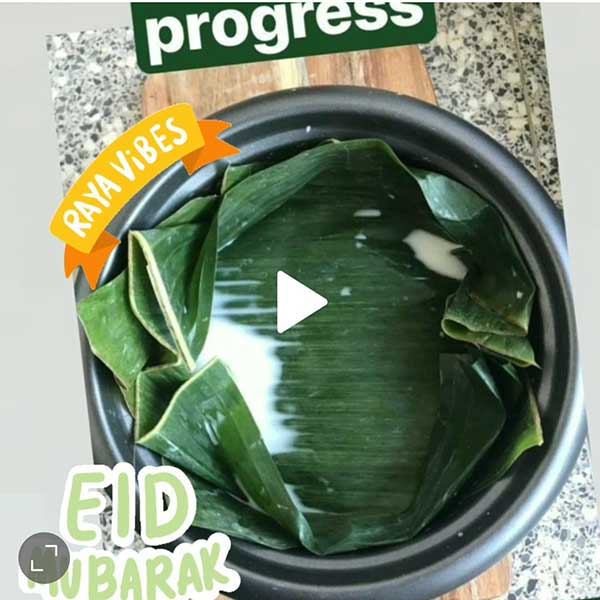


Comments by LinsFoodies
As mentioned, this recipe’s been moved from its original site, all the many, many comments have sadly been lost. Here are just some of them for posterity!
O wow ! this is amazing. Finally I get to make Lemang . I missed it so much. Looking forward to try more of your recipes.
Gladys Bishop
Thank you, you’re a lifesaver. Just made them, will barbecue tomorrow.
Sayed
Thanks very much for being so detail and sharing your love of cooking for everyone.
Tim
Ah, thank you, Lin. I really miss lemang from home. Definitely making this for Raya. Will you email me when you have the stuffed lemang posted, please? Thank you!
Norliza
Damn, this is pure genius, Chef! I never would have thought to bbq the leaves! Thank you, it’s going on the Eid menu. The wife will cook it, I’ll bbq it! Eid Mubarak!
Khalid Maidin
And many, many more! Keep the comments coming, folks, and the images!
Shall we get cooking?
♥ If you like the recipe, don’t forget to leave me a comment and that all important, 5-star rating! ? Thank you! ♥
And if you make the recipe, share it on any platform and tag me @azlinbloor, and hashtag it #linsfood
Lin xx
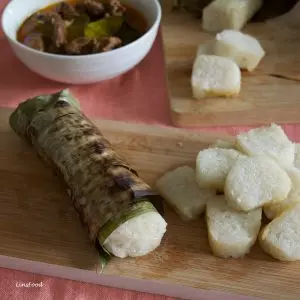
How to Make Lemang without Bamboo (Resepi Lemang Tanpa Buloh)
Equipment
- saucepan or rice cooker
- barbecue or oven for roasting the finished lemang rolls
- ladles, scissors, cocktail sticks
Ingredients
- 500 g glutinous rice, soaked for 3 hours
- 250 ml coconut milk
- 250 ml water
- 1 Tbsp salt
- 1 tsp sugar
- 2 pandan leaves
- a few sheets of banana leaves
- a drop of flavourless oil for greasing like vegetable oil
Instructions
- Soak the rice for a minimum 3 hours, or overnight, if you have the time.
- Drain, rinse and drain again. Set aside.
- Cut the banana leaves to manageable sizes and soften them as in the video and instructions above.
- Lightly grease your chosen pan or rice cooker, then line with 1 or 2 banana leaves, depending on their size.
- Tip the rice in, followed by the salt and sugar.
- Add the coconut milk and water, followed by the pandan leaves. Tie the pandan into a knot (see video at 1:45) and push down into the rice slightly.
- Top with banana leaf, cover and bring to a boil on high heat. Then lower the heat right down and simmer for 30 minutes until the liquid’s all gone and the rice is beautifully soft.
- When cooked, discard the leaves. Let the rice cool down slightly, so you don’t burn yourself. You could tip the rice out onto a large plate or platter, spread it out to let it cool faster.
- When ready, form the rice into thick sausages and place on a banana leaf at the end without the thick vein. Roll up carefully, being careful not to rip the leaf too much. This is especially important with frozen leaves, as they tend to be fragile.
- Secure the ends and the middle with cocktail sticks, tightening the leaf, as necessary. Please see the video for this.
Browning the Lemang
EITHER
- Preheat the oven to 220˚C/425˚F.
- Place the lemang rolls on a baking sheet and bake for 30 minutes until the leaves are charred and smoky smelling.
- Take them out of the oven, leave to cool slightly, as you don’t want to burn your fingers, and slice with a wet knife. Makes a great side to any meal!
OR
- Soak 2 handfuls of wood chips in water for 20 minutes and light your barbecue (grill, in American speak).
- Drain the wood chips and scatter all over your ready coals.
- Place the lemang rolls on the barbecue and leave them to “burn” for a good 30 minutes or so, depending on how hot your barbie is. You want the banana leaves to be brown and dry for the best flavour and aroma.
- Take them off the barbecue, leave to cool slightly, as you don’t want to burn your fingers, and slice with a wet knife. Makes a great side to any barbecue this summer!

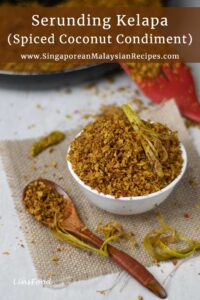
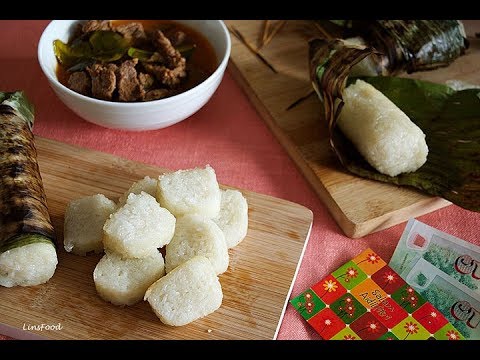
20 thoughts on “How to Make Lemang without Bamboo (Resepi Lemang Tanpa Buloh)”